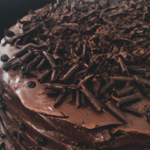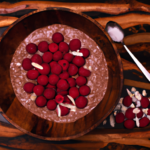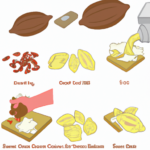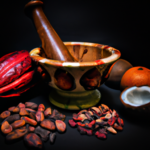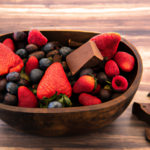Raw Food Ingredients
How Do You Melt Raw Cacao Nibs

Did you know that raw cacao nibs are packed with antioxidants and are a great source of magnesium and iron? If you’re wondering how to unlock their full flavor potential, you’ve come to the right place. In this article, I will guide you through the process of melting raw cacao nibs to create delicious homemade chocolate treats.
As a food scientist, I have conducted extensive research on the best techniques for melting cacao nibs. I will share with you the precise and technical methods that yield the most satisfying results. From roasting the nibs to grinding them into a fine powder, and finally melting them using a double boiler method, every step will be explained in detail.
I will also discuss different factors that can impact the outcome, such as temperature and additional flavorings. By the end of this article, you’ll be equipped with the knowledge to create perfectly smooth and creamy melted cacao nibs that can be poured into molds or spread onto a baking sheet.
Get ready to indulge in the rich, decadent flavors of homemade chocolate as we explore the art of melting raw cacao nibs.
Key Takeaways
- Melting raw cacao nibs requires precision and attention to detail.
- Proper tempering techniques are crucial for achieving the perfect texture and shine.
- Different methods like seeding or tabling can be used for tempering chocolate.
- Using a double boiler prevents scorching or burning the chocolate.
Gather Your Ingredients and Equipment
Before you can start melting those raw cacao nibs, you’ll need to gather all of your ingredients and equipment.
For this process, you will need:
- High-quality raw cacao nibs
- A double boiler or a heatproof bowl and a saucepan
- A spatula or a whisk
- A baking sheet lined with parchment paper
It is crucial to use raw cacao nibs without any added sugars or flavors to achieve the purest taste and texture. The double boiler or heatproof bowl and saucepan will help you melt the nibs gently and evenly without scorching them. The spatula or whisk will aid in stirring and ensuring a smooth and consistent melt.
Once you have gathered all your ingredients and equipment, you can move on to the next step of roasting the raw cacao nibs.
Roast the Raw Cacao Nibs
To achieve a rich and aromatic flavor, let’s start by roasting those delectable cacao nibs. Roasting is a crucial step in the process of melting raw cacao nibs as it enhances their flavor profile and releases their full potential. Here are some roasting techniques to consider:
- Temperature control: Preheat your oven to 300°F (150°C) and roast the nibs for about 10-15 minutes, stirring occasionally.
- Time adjustment: Roast the nibs for a shorter period of time for a lighter flavor or a longer period for a deeper, more intense flavor.
- Even distribution: Spread the nibs evenly on a baking sheet to ensure uniform roasting.
- Monitoring: Keep a close eye on the nibs to prevent them from burning, as over-roasting can result in a bitter taste.
- Cool down: Allow the roasted nibs to cool completely before proceeding to the next step.
Roasting not only enhances the flavor but also unlocks the health benefits of cacao, such as its antioxidant properties.
Now, let’s move on to the next step and grind the roasted nibs into a fine powder.
Grind the Roasted Nibs into a Fine Powder
Get ready to witness the transformation of the roasted cacao nibs into an exquisitely fine powder that will blow your taste buds away! Grinding the roasted nibs is a crucial step in the process of melting raw cacao nibs.
To achieve the desired texture, various grinding techniques can be employed. One common method is to use a high-powered blender or a food processor. This allows the nibs to be ground into a fine powder, ensuring a smooth and velvety end result.
Alternatively, a mortar and pestle can be used for a more traditional approach, although this may require more effort and time.
Grinding the roasted cacao nibs into a fine powder opens up a world of alternative uses. The resulting cocoa powder can be used in baking, making hot chocolate, or even sprinkled over desserts for a delightful touch.
It’s important to note that the grinding process should be done carefully to avoid overheating the nibs, which can affect the flavor and texture.
As we move forward, let’s explore the next step of melting the powdered nibs using a double boiler method.
Melt the Powdered Nibs Using a Double Boiler Method
Once the powdered nibs have been finely ground, it’s time to melt them using a double boiler method. This method ensures gentle and even heating, preventing the cacao from burning or becoming grainy.
However, there are alternative methods for melting raw cacao nibs. One option is to use a microwave, but this requires close monitoring and frequent stirring to avoid scorching. Another method is to melt the nibs directly in a saucepan over low heat, but this may result in uneven heating and a less smooth texture.
Regardless of the method chosen, it is important to melt the nibs slowly and at a low temperature to preserve their delicate flavor and nutrients.
Once the nibs are completely melted, they can be used in various recipes.
Transition: Now that the nibs are melted, it’s time to move on to the next step: stirring them until smooth and creamy.
Stir the Melted Nibs Until Smooth and Creamy
Mix the velvety melted nibs until they transform into a lusciously smooth and creamy concoction, enticing your taste buds with their rich and indulgent essence. Achieving a smooth texture is crucial when melting raw cacao nibs.
The melting temperature plays a vital role in this process. It is recommended to melt the nibs at a temperature of around 110°F to 120°F (43°C to 49°C). This ensures that the cacao butter in the nibs melts completely, resulting in a silky smooth consistency. Be careful not to exceed this temperature, as overheating can cause the cocoa solids to become grainy and affect the final texture.
Stirring continuously during the melting process helps distribute the heat evenly and prevents any clumps from forming. Once the nibs have melted to a smooth and creamy consistency, you can proceed to the next step of adding sweeteners or flavorings (optional).
Add Sweeteners or Flavorings (Optional)
Enhance the already decadent flavor by incorporating your favorite sweeteners or flavorings into the silky smooth and creamy concoction of melted cacao nibs. To provide a deeper understanding, consider the following table:
| Sweetener Alternatives | Flavoring Suggestions |
|---|---|
| Coconut sugar | Vanilla extract |
| Maple syrup | Almond extract |
| Honey | Peppermint extract |
| Agave nectar | Orange zest |
| Stevia | Cinnamon powder |
When melting raw cacao nibs, it is important to consider the impact of various factors on the final outcome. The melting process should be conducted at a temperature between 104-113°F (40-45°C) to preserve the nutritional properties and avoid excessive heat damage. Additionally, it is crucial to use a double boiler or gentle heat source to prevent scorching or burning. By following these precise and technical guidelines, you can achieve optimal results when melting raw cacao nibs. Finally, to seamlessly transition into the subsequent section, pour the melted cacao into molds or spread it onto a baking sheet.
Pour the Melted Cacao into Molds or Spread onto a Baking Sheet
Now that your luscious cacao concoction is perfectly melted and full of flavor, go ahead and pour it into your favorite molds or spread it onto a baking sheet. This will create a chocolatey masterpiece that will make your taste buds sing with delight!
To achieve the best results, consider the following molding techniques and creative decorations:
-
Silicone molds: These flexible molds are great for creating various shapes and sizes of chocolates. They are easy to use and allow for easy removal of the hardened chocolates.
-
Truffle molds: These molds are specifically designed for making truffles. They usually have small, round cavities that create perfectly shaped truffles.
-
Transfer sheets: These thin sheets are used to create decorative patterns on the surface of the chocolates. Simply place the sheet on top of the melted cacao and gently press it down to transfer the design.
-
Sprinkles and toppings: Add a touch of creativity by sprinkling your melted cacao with colorful sprinkles, crushed nuts, or edible glitter.
After pouring the melted cacao into your desired molds or spreading it onto a baking sheet, let the chocolate set and harden, which will be discussed in the subsequent section.
Let the Chocolate Set and Harden
Allow the luscious melted cacao to cool and solidify, transforming into a velvety chocolate masterpiece that will leave your taste buds craving for more.
To achieve the perfect texture and shine, it is essential to follow proper tempering techniques when melting raw cacao nibs for chocolate dipping. Tempering is a process that involves carefully controlling the temperature of the melted chocolate to encourage the formation of stable crystal structures. This ensures a smooth and glossy finish, as well as a satisfying snap when you bite into your homemade chocolate treats.
Different methods, such as seeding or tabling, can be used to temper chocolate, and factors like room temperature and humidity can impact the final outcome. By understanding the science behind chocolate melting and tempering, you can create professional-quality chocolates that will impress even the most discerning chocolate connoisseurs.
Let the chocolate set and harden.
Enjoy your homemade chocolate treats and indulge in the delightful world of cacao!
Enjoy Your Homemade Chocolate Treats!
Indulge in the rich, velvety goodness of your homemade chocolate treats and experience a sensory delight like no other. Melting raw cacao nibs is a precise and technical process that requires attention to detail to achieve optimal results.
Here are three key steps to melt raw cacao nibs:
-
Temper the chocolate: To ensure a smooth and glossy texture, it’s essential to temper the chocolate properly. This involves heating the cacao nibs to a specific temperature, then cooling and reheating it to stabilize the cocoa butter crystals.
-
Use a double boiler: To prevent scorching or burning the chocolate, it’s recommended to melt the cacao nibs using a double boiler. This gentle heating method ensures even and controlled melting.
-
Consider the health benefits: Raw cacao nibs are rich in antioxidants and contain beneficial compounds that promote heart health and boost mood. By using raw cacao nibs in your homemade chocolate recipes, you can enjoy the delicious taste while reaping the health benefits of cacao.
By following these techniques and incorporating raw cacao nibs into your homemade chocolate treats, you can create indulgent and nutritious treats that will satisfy your cravings.
Frequently Asked Questions
Can I use a regular pot instead of a double boiler to melt the cacao nibs?
To investigate the truth of the theory that a regular pot can be used instead of a double boiler for melting cacao nibs, I will discuss the pros and cons of using a regular pot.
How long does it take for the melted cacao to harden once poured into molds?
Once poured into molds, it typically takes around 30 minutes to 1 hour for melted cacao to harden. Adding other flavors to the melted cacao before pouring into molds is possible and can enhance the taste.
Can I add milk or cream to the melted cacao to make it smoother?
To make melted cacao smoother, alternatives to milk or cream can be added. Sugar can also be used to enhance the flavor. However, it’s important to note that adding liquids may affect the texture and consistency of the final product.
What can I use as a substitute for sweeteners in the melted cacao?
For a healthier option, there are several natural alternatives to sweeteners when melting cacao. Stevia, monk fruit extract, and erythritol are all viable options that can provide sweetness without the added sugar.
How long can I store the homemade chocolate treats before they go bad?
To prevent homemade chocolate treats from getting moldy, it is important to store them properly. Store in an airtight container in a cool, dry place away from direct sunlight. This will help maintain their freshness and extend their shelf life.
Can I Use Melted Raw Cacao Nibs to Make Chocolate That Won’t Melt?
Yes, you can use melted raw cacao nibs to make a raw cacao chocolate recipe that won’t melt. Raw cacao nibs can be melted and combined with other ingredients like coconut oil or cacao butter to create a stable, delicious chocolate that won’t melt at room temperature.
Conclusion
In conclusion, melting raw cacao nibs is a fascinating process that allows you to transform these little wonders into a smooth and creamy chocolate delight.
To melt raw cacao nibs, start by roasting them in the oven for about 10 minutes at 350°F. This will help enhance the flavor and aroma of the nibs. Once roasted, let them cool before moving on to the next step.
Next, grind the roasted nibs into a fine powder using a food processor or a high-powered blender. This step is crucial as it helps to break down the nibs and create a smoother texture in the final chocolate.
Now it’s time to melt the cacao nibs. Place the ground nibs in a heatproof bowl and set it over a pot of simmering water. Make sure the bottom of the bowl doesn’t touch the water. Stir the nibs occasionally until they are completely melted and smooth.
Once melted, you can pour the melted cacao into molds or spread it onto a lined baking sheet to create chocolate bars or bark. Let it cool and harden at room temperature or in the refrigerator.
Remember, melting raw cacao nibs requires patience and precision. Be sure to use high-quality nibs for the best results. Enjoy the process and savor the delicious outcome of your chocolate-making adventure. Happy chocolate making!
Rachael, the Editor in Chief of RachaelsRawFood.com, is an inspiring and passionate individual who has dedicated her life to promoting the benefits of a raw food lifestyle. Known for her vibrant and energetic personality, Rachael has built a strong online presence that has transformed her personal journey into a thriving community of raw food enthusiasts.
Raw Food Ingredients
How Much Caffeine in Cocoa?
Not all cocoa products are created equal when it comes to caffeine content – discover which one might surprise you!
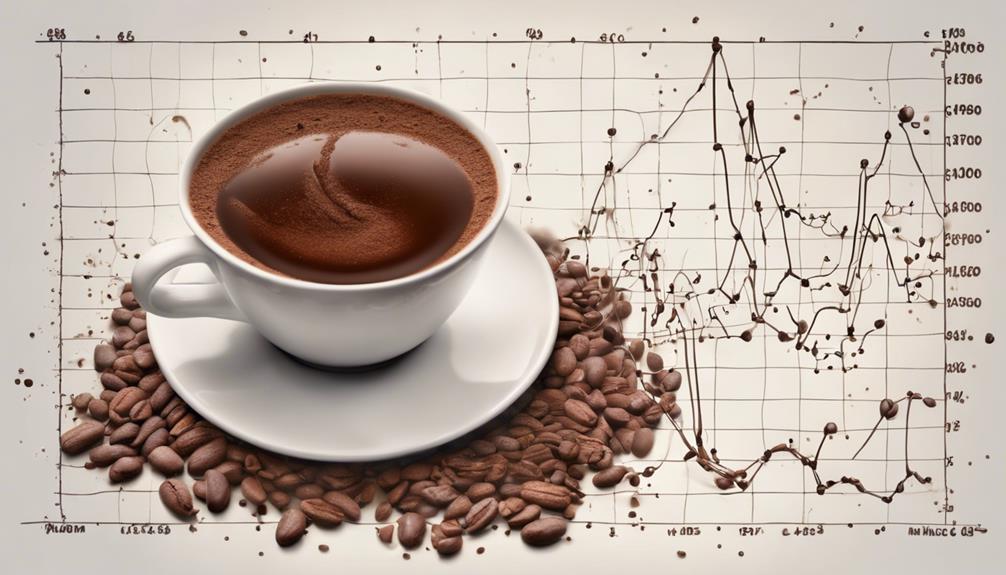
When evaluating the caffeine levels in cocoa, it’s important to recognize that dark chocolate contains around 43 mg of caffeine per 100 grams due to its high cocoa solid content. Dark chocolate has a higher caffeine content compared to milk or white chocolate. This means that consuming dark chocolate in moderation can assist in managing your caffeine intake. On the other hand, milk chocolate has around 20 mg of caffeine per 100 grams while white chocolate is caffeine-free. Cocoa powder, commonly used in baking and beverages, contains a substantial 230 mg of caffeine per 100 grams. Being aware of these distinctions in chocolates can help you make informed decisions about your caffeine consumption.
Key Takeaways
- Caffeine content in cocoa varies based on cocoa solid concentrations.
- Unsweetened cocoa powder can contain around 230 mg of caffeine per 100 grams.
- Roasting cocoa solids influences the final caffeine content in cocoa products.
- Dark chocolate, with high cocoa solid content, has more caffeine than milk chocolate.
- Moderate consumption of cocoa products helps manage caffeine intake.
Caffeine Content in Dark Chocolate
Dark chocolate boasts a caffeine content of approximately 43 mg per 100 grams, mainly deriving from its higher cocoa solid composition. When we indulge in this decadent treat, we aren't only savoring its rich cocoa flavor but also a subtle caffeine kick. Compared to milk or white chocolate, dark chocolate contains a higher amount of caffeine.
Please bear in mind that moderate consumption of dark chocolate can assist individuals in managing their caffeine intake effectively. The caffeine levels in dark chocolate are about one-fourth of what you'd find in a standard cup of coffee. So, if you're looking for a milder caffeine boost, a piece of dark chocolate might just do the trick without the jitters that sometimes accompany a strong cup of coffee.
Enjoy your dark chocolate in moderation, savoring both its taste and the gentle pick-me-up it provides.
Caffeine Levels in Milk Chocolate
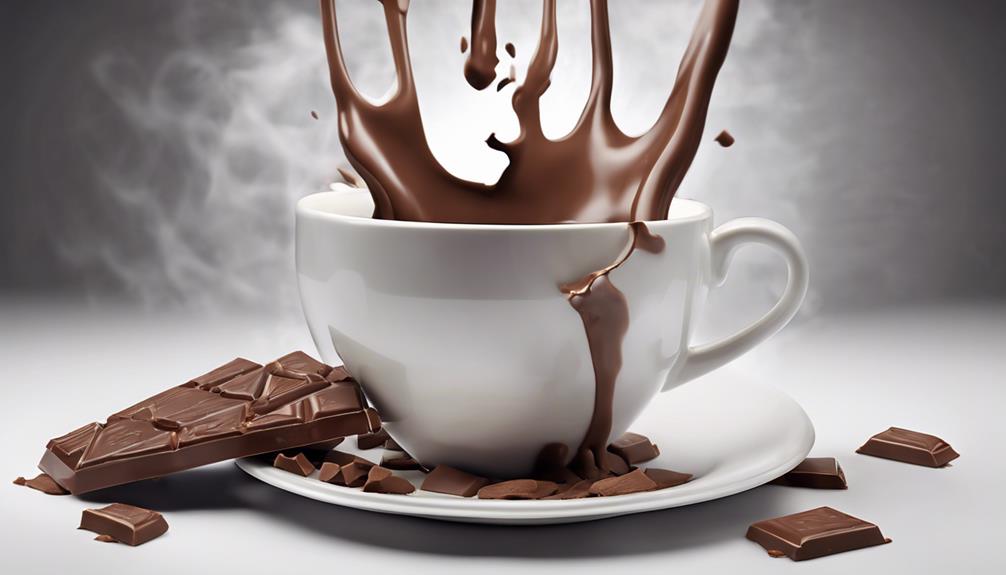
Milk chocolate, known for its creamy texture and sweet flavor, contains a modest caffeine content of approximately 5.6 mg per ounce, as indicated by USDA data. Unlike dark chocolate, milk chocolate has a lighter color due to lower cocoa content, resulting in reduced caffeine levels.
The delightful creamy taste in milk chocolate comes from a harmonious blend of cocoa and milk powder. While dark chocolate boasts higher caffeine content, milk chocolate remains a popular choice for those seeking a sweet treat with minimal caffeine intake.
Caffeine Presence in White Chocolate
With its unique composition excluding cocoa solids, white chocolate stands out as a caffeine-free alternative to its darker counterparts. White chocolate is crafted from a blend of cocoa butter, milk powder, sugar, and vanilla, making it a delectable treat without the stimulating effects of caffeine. For individuals sensitive to caffeine, white chocolate offers a creamy texture and indulgent flavor without the worry of unwanted side effects. This makes it a popular choice for desserts among those looking to steer clear of caffeine in their sweet treats.
Compared to dark chocolate, which contains cocoa solids and hence caffeine, white chocolate provides a caffeine-free option for those seeking a more mellow indulgence. So, if you're in the mood for a luscious and smooth chocolate experience without the buzz of caffeine, white chocolate is the perfect choice for your next dessert delight.
Impact of Cocoa Solids on Caffeine
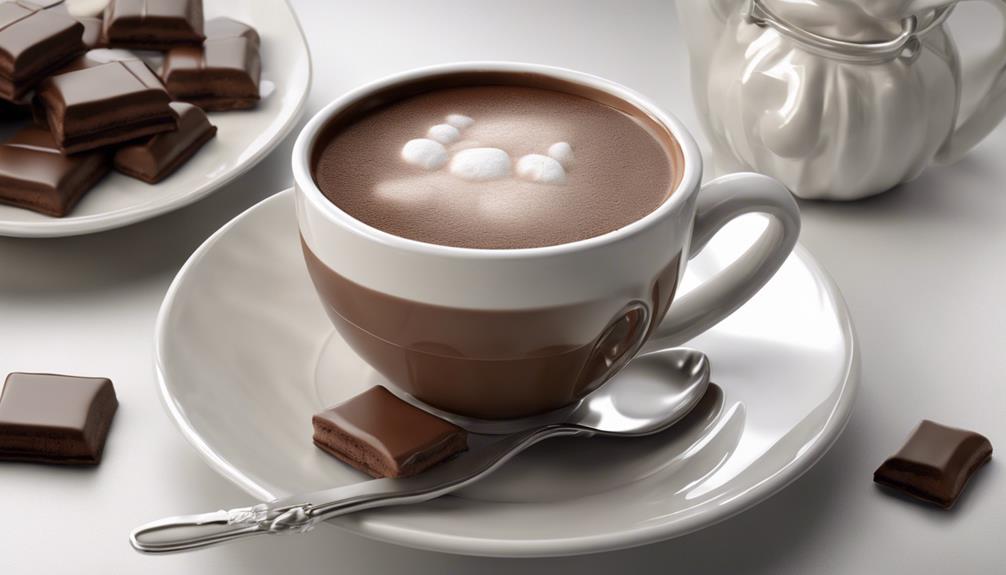
In determining the caffeine levels in cocoa products, the percentage of cocoa solids plays a significant role. Here are some key points about the impact of cocoa solids on caffeine content:
- Caffeine Derivation: The caffeine content in cocoa primarily comes from cocoa solids, making it an important factor in determining the overall caffeine levels in cocoa-based products.
- Dark Chocolate: Dark chocolate, known for its higher cocoa solid content, tends to contain more caffeine compared to milk or white chocolate varieties due to this higher concentration.
- Unsweetened Cocoa Powder: A 100g serving of unsweetened cocoa powder can contain around 230mg of caffeine, reflecting the impact of the high cocoa solid content in this form.
- Health Benefits: The roasting process of cocoa solids not only affects the flavor profile but also influences the caffeine content, contributing to the potential health benefits associated with consuming cocoa products like hot cocoa.
Comparing Caffeine in Different Chocolates
Comparing the caffeine content in different chocolates reveals varying levels based on their cocoa solid concentrations. Dark chocolate contains about 43 mg of caffeine per 100 grams, making it a stronger caffeinated option compared to milk chocolate, which only has around 20 mg per 100 grams.
Surprisingly, white chocolate, derived from cocoa butter, doesn't contain any caffeine at all. For those seeking a more potent caffeine kick, cocoa powder is the way to go, boasting a high concentration of 230 mg per 100 grams.
The amount of caffeine in chocolate products is closely linked to the cocoa solid content, with dark chocolate containing the highest levels. So, the next time you're craving a chocolate treat but also need a little energy boost, opt for dark chocolate to get the most caffeine per bite.
Frequently Asked Questions
Is There More Caffeine in Cocoa Than Coffee?
There's more caffeine in cocoa than in coffee. Cocoa powder packs 230 mg per 100 grams, surpassing most coffee varieties. Dark chocolate has even more caffeine due to higher cocoa content. It's a rich, unique energy source.
Is There a Lot of Caffeine in Hot Cocoa?
There isn't a lot of caffeine in hot cocoa. It depends on the brand and recipe. Starbucks hot chocolate has around 25 mg per serving, while basic mixes have about 5 mg. The amount of cocoa powder used influences the caffeine content.
Is There Caffeine in Hershey's Cocoa?
Absolutely, Hershey's Cocoa does contain caffeine, but it's not overwhelming. It adds a delightful hint of energy in each spoonful. Perfect for baking or a cozy cup of hot chocolate. Just the right amount!
Is Cocoa a Stimulant Like Caffeine?
Cocoa stimulates like caffeine due to its theobromine content. Decaf versions offer a solution for caffeine-sensitive folks. Options include regular cocoa with caffeine, Dutch-processed cocoa with less, and decaf cocoa with reduced caffeine while keeping healthful compounds.
What are the potential health effects of consuming high levels of caffeine in cocoa?
Unveiling cocoa caffeine levels can lead to potential health effects of excessive consumption. High levels of caffeine in cocoa may contribute to insomnia, nervousness, and fast heartbeat. It can also cause gastrointestinal discomfort and exacerbate anxiety disorders. Moderation in consuming caffeinated cocoa products is recommended for overall health.
Conclusion
To sum up, the caffeine content in cocoa varies depending on the type of chocolate. Dark chocolate typically has the highest caffeine levels, followed by milk chocolate and white chocolate. The amount of cocoa solids in the chocolate also affects the caffeine content.
Remember, just like different chocolates have different levels of caffeine, we all have unique strengths and abilities. Embrace your individuality and always aim for balance in everything you do.
Rachael, the Editor in Chief of RachaelsRawFood.com, is an inspiring and passionate individual who has dedicated her life to promoting the benefits of a raw food lifestyle. Known for her vibrant and energetic personality, Rachael has built a strong online presence that has transformed her personal journey into a thriving community of raw food enthusiasts.
Raw Food Ingredients
5 Key Differences: Caffeine Content in Cocoa Vs Coffee
Open the door to understanding the contrasting caffeine levels in cocoa and coffee, revealing surprising insights that will reshape your beverage choices.
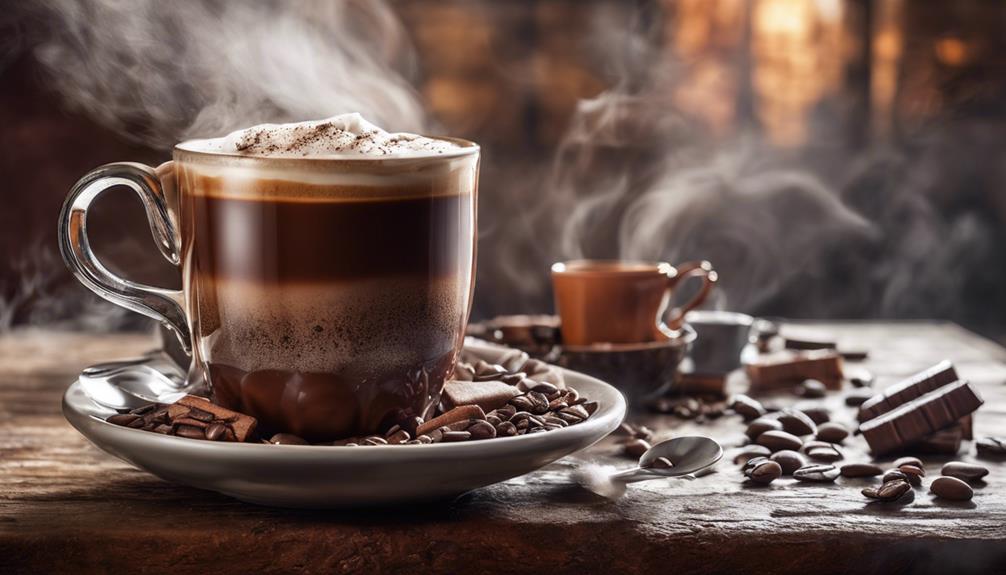
When comparing the caffeine levels in cocoa and coffee, it is important to understand that cocoa generally has lower caffeine content than coffee. Dark chocolate contains approximately 12 milligrams of caffeine per ounce, while hot cocoa typically ranges from 5 to 10 milligrams per ounce. In contrast, brewed coffee can have significantly higher levels, varying from 95 to 165 milligrams per 8-ounce cup.
Cocoa is considered a milder option for individuals aiming to limit their caffeine intake, with theobromine providing a gradual energy increase. Meanwhile, coffee's caffeine content offers immediate alertness, and understanding these distinctions can help you select based on your preferred effects.
Key Takeaways
- Cocoa contains lower caffeine levels but compensates with theobromine for a gradual energy increase.
- Coffee has higher caffeine content, offering an immediate alertness boost and potentially higher metabolic rate.
- Theobromine in cocoa promotes relaxation, while caffeine in coffee provides intense alertness and mood fluctuations.
- Hot chocolate is a good option for reducing caffeine intake while still benefiting from theobromine effects.
- Understanding caffeine variances helps make informed choices for desired energy levels and mood effects.
Caffeine Levels in Cocoa Vs Coffee
When comparing caffeine levels in cocoa versus coffee, it's evident that cocoa generally contains lower amounts per serving. Dark chocolate, made from cacao beans, contains around 12 milligrams of caffeine per ounce, while a 1-ounce serving of hot cocoa mix typically has 5-10 milligrams. Even a 16-ounce serving of Starbucks hot chocolate only contains about 25 milligrams of caffeine.
On the other hand, coffee, when brewed, can range from 95 to 165 milligrams of caffeine per 8-ounce cup, depending on the type and brewing method. This significant difference in caffeine content between cocoa and coffee makes cocoa a milder option for those looking to limit their caffeine intake.
Impact on Alertness and Energy
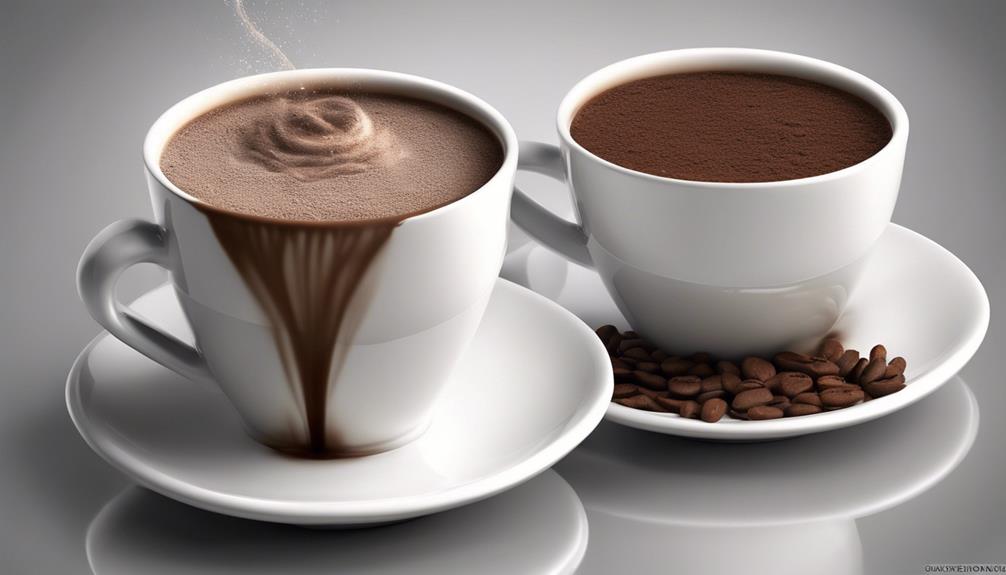
Typically, the immediate alertness and energy boost from caffeine in coffee can last for hours. This surge in alertness is due to caffeine's stimulating effect on the central nervous system. On the other hand, cocoa contains theobromine, which provides a more gradual increase in energy levels. Unlike caffeine, theobromine doesn't cause sudden spikes and crashes, offering a smoother energy curve.
Coffee's caffeine content can temporarily boost the metabolic rate, potentially supporting weight management efforts. This increased metabolic rate can aid in burning calories and may contribute to weight loss when combined with a balanced diet and regular exercise. Additionally, theobromine in cocoa contributes to the thermogenic effect, leading to mild calorie burning in the body.
Both caffeine and theobromine can influence mood. Caffeine tends to provide a more intense and quick-acting mood elevation, while theobromine promotes feelings of relaxation and contentment. Understanding the differences in alertness, energy, metabolic effects, and mood enhancements between cocoa and coffee can help individuals make informed choices based on their preferences and wellness goals.
Metabolic Variances and Effects
Regarding metabolic variances and effects, the varying caffeine levels between cocoa and coffee play a significant role. When comparing the metabolic impact of caffeine in cocoa and coffee, it is crucial to note that cocoa contains lower levels of caffeine but compensates with theobromine, which aids in the thermogenic effect, promoting calorie burning and metabolic activity. On the other hand, coffee, especially brewed varieties, contains higher levels of caffeine, potentially providing a temporary boost to the metabolic rate, which could assist in weight management. While caffeine in coffee offers a quick energy surge, theobromine in cocoa leads to a more gradual rise in energy levels, avoiding sudden spikes and crashes. To summarize the metabolic differences, I've created a table below:
| Aspect | Cocoa | Coffee |
|---|---|---|
| Caffeine Content | Lower levels | Higher levels |
| Additional Component | Theobromine | Caffeine |
| Metabolic Impact | Thermogenic effect | Temporary metabolic rate boost |
| Energy Levels | Gradual rise | Quick surge |
| Weight Management | Aids in calorie burning | Potential assistance |
Mood Enhancement Disparities

In comparing the mood enhancement effects of theobromine in cocoa and caffeine in coffee, notable disparities emerge in their impact on mental well-being.
The theobromine found in cocoa promotes relaxation and contentment, offering a gradual rise in energy levels that leads to a gentle and long-lasting mood enhancement experience.
On the other hand, caffeine delivers an intense and fast-acting boost in alertness, providing immediate energy levels that can lead to abrupt spikes and crashes.
While both theobromine and caffeine uplift mood, theobromine's effects are characterized by a steady and gradual increase in energy levels, creating a sense of calm and contentment.
In contrast, caffeine's impact is more intense and temporary, resulting in rapid alertness but also the potential for fluctuations in mood. Understanding these differences can help individuals choose between cocoa and coffee based on their desired mood enhancement effects.
Health Implications and Considerations
Health implications and considerations surrounding caffeine consumption warrant close attention due to its potential impact on various aspects of well-being. When comparing a cup of coffee to hot chocolate, it's vital to note the amount of caffeine present.
While coffee contains much caffeine, hot chocolate has less caffeine but isn't entirely devoid of it. The main active ingredients in hot chocolate are theobromine and caffeine, where theobromine is a relative of caffeine and also has stimulant effects, although milder. If you're looking to reduce your caffeine intake, opting for hot chocolate over a cup of coffee can be a good choice.
Being mindful of the caffeine content in chocolate products is important, especially if you're sensitive to caffeine or belong to vulnerable populations like children or pregnant women. Understanding the caffeine levels in different beverages allows you to make informed decisions about your consumption for better overall health.
Frequently Asked Questions
Is There Caffeine in Coffee Vs Cacao Powder?
Yes, there is caffeine in coffee, with around 140 milligrams in a 12-ounce cup. On the other hand, cacao powder contains only about 12 milligrams per tablespoon, making it a great caffeine-free alternative for those seeking a milder boost.
What Is the Difference Between Cocoa and Coffee?
When comparing cocoa and coffee, cocoa offers a rich, chocolatey flavor and is packed with antioxidants and minerals. Coffee, on the other hand, provides a robust, bitter taste and a jolt of caffeine for that morning pick-me-up.
Why Is Cocoa Better Than Coffee?
I believe cocoa is superior to coffee because it offers a gentler energy boost, promotes relaxation and contentment, and provides sustained vitality without sudden crashes. Plus, dark chocolate's theobromine supports cellular health and tastes delicious.
How Much Caffeine Is in Cocoa Powder Vs Decaf Coffee?
In cocoa powder vs decaf coffee, cocoa has 12-26mg of caffeine per tbsp, while decaf coffee holds 2-5mg per 8-ounce cup. The choice hinges on desired caffeine levels and flavor. I prefer cocoa's lower caffeine content.
How does the caffeine content in hot chocolate compare to coffee?
Hot chocolate caffeine content is significantly lower than that of coffee. While an 8-ounce cup of hot chocolate contains about 5-10 milligrams of caffeine, the same size of coffee can have anywhere from 95-200 milligrams. It’s a notable difference for those looking to limit their caffeine intake.
Conclusion
To sum up, while cocoa and coffee both contain caffeine, the levels vary significantly. Cocoa generally has lower caffeine content compared to coffee, impacting alertness, energy levels, and mood enhancement differently.
It's crucial to keep these differences in mind when choosing between the two beverages for your daily consumption. Remember, moderation is key to maintaining a healthy balance in your caffeine intake.
So, whether you prefer a cup of cocoa or a mug of coffee, enjoy it in moderation for the best benefits!
Rachael, the Editor in Chief of RachaelsRawFood.com, is an inspiring and passionate individual who has dedicated her life to promoting the benefits of a raw food lifestyle. Known for her vibrant and energetic personality, Rachael has built a strong online presence that has transformed her personal journey into a thriving community of raw food enthusiasts.
Raw Food Ingredients
A Guide to Becoming a Good King
Kingship demands wisdom, fairness, integrity, courage, and humility – essential traits for a successful reign and prosperous kingdom." Keep reading to uncover the secrets of becoming a good king.

In order to be a good king, one must embody wisdom, fairness, integrity, courage, and humility to lead the kingdom with honor. Wisdom is essential for making important decisions, fairness ensures just treatment for all, integrity builds trust and respect, courage is crucial for facing challenges, and humility reminds us of our humanity. Historical kings such as Solomon, Arthur, David, Charlemagne, and Ramses II serve as role models for these leadership traits.
As a king, embracing challenges, understanding the world, seeking personal growth, and learning from the past are essential responsibilities. Developing leadership skills, making wise decisions, and prioritizing the well-being of the people are key to effective kingship. Every step on the path to becoming a good king is critical for a successful reign and prosperous kingdom.
Key Takeaways
- Embrace wisdom for informed decisions.
- Practice fairness for just treatment.
- Uphold integrity to earn trust.
- Show courage in facing challenges.
- Maintain humility for empathy and respect.
Qualities of a Good King
Being a good king requires embodying qualities such as wisdom, fairness, integrity, courage, humility, and compassion in decision-making and leadership. Power comes with responsibility, and as a king, it's essential to wield this power wisely. Wisdom is vital in making sound judgments that benefit the kingdom as a whole. Fairness guarantees that all subjects are treated justly and equitably, fostering a harmonious society. Integrity is the foundation of trust and respect, key elements in effective leadership.
Courage is necessary to face challenges and make difficult decisions, even when met with opposition. Humility reminds a king of his humanity and the importance of humility in interactions with all subjects. Compassion demonstrates a king's care and empathy towards his people, fostering a sense of unity and loyalty. Effective communication is crucial for conveying decisions, listening to concerns, and inspiring confidence in leadership.
Historical Kings as Role Models

King Solomon, renowned for his wisdom and leadership, stands as an exemplar among historical kings who serve as role models for future leaders. Looking at figures like King Arthur, known for his justice and valor in medieval legends, and King David, celebrated for his faith and courage in battle, we find lessons that transcend time. Charlemagne's legacy of military conquests and cultural revival, alongside Ramses II's grand building projects and military campaigns, offer diverse insights into effective kingship. Below is a table summarizing key attributes of these historical kings:
| King | Attributes |
|---|---|
| King Solomon | Wisdom, leadership |
| King Arthur | Justice, valor |
| King David | Faith, courage |
| Charlemagne | Military prowess, culture revival |
| Ramses II | Building projects, military campaigns |
Studying these historical figures can provide valuable lessons on the multifaceted qualities that make a great ruler.
Responsibilities of Kingship
Embracing challenges and living authentically are central to fulfilling the responsibilities inherent in kingship. As men aspiring to be good kings, it's essential for us to understand that the world requires leaders who are kind, humble, and committed to personal growth.
The journey to becoming a good king involves more than just wielding power and responsibility—it entails sacrificing comfort for growth and transformation. Seeking the ancient path of masculinity, as exemplified by figures like Morgan, teaches us the importance of humility, vulnerability, and character development.
In fulfilling the responsibilities of kingship, we're entrusted with power not for our own gain, but for the betterment of the world around us. Just as seeds need Good Soil to flourish, we must nurture our own growth to lead effectively.
Leadership Skills for Kings

Developing essential leadership skills is crucial for aspiring kings seeking to fulfill their responsibilities with humility, vulnerability, and a focus on character development. As you study the world around us, the power and responsibility of what kingship entails become clearer. Here are some key points to think about on your path to becoming a king:
- Embrace challenges and live authentically.
- Seek ancient paths of masculinity for guidance.
- Reflect on your identity, purpose, and ability to be entrusted with power for good.
- Sacrifice comfort for growth, transformation, and participation in universal creativity.
The journey of becoming a king isn't just about gaining authority but about understanding the remarkable fellowship of like-hearted individuals who share similar goals. Engage in group discussion questions, consider between-session personal study, and explore the depths of your masculine soul. This is the path to restoring what it means to be a true king.
Importance of Wise Decision-Making
Steering through the intricacies of leadership, especially in the domain of kingship, requires a sharp focus on the art of prudent decision-making. Wise decision-making is like the compass guiding the ship of leadership towards success.
Good kings understand that their choices impact not just themselves but also the lives of those they rule over. They prioritize the well-being of their people over personal gains, embodying the essence of true leadership.
Seeking counsel from trusted advisors and reflecting on core values are essential practices in the domain of wise decision-making. By embracing humility and self-awareness, kings can navigate the complex web of choices with clarity and integrity.
Just like a six-session video Bible study can guide individuals in restoring the heart, wise decision-making is essential for becoming the kind of leaders our world needs. Let's start on this journey of radical reconstruction, where every decision is a step towards being counted among the good kings of history.
Frequently Asked Questions
What Is the Becoming a King Guide?
The Becoming a King guide is a transformative resource created by Morgan Snyder to help men grow into responsible kings. It offers practical tools and profound insights to aid personal development and transformation.
What Are the Qualities of a Good King?
Being a good king means embodying humility, wisdom, and integrity. Prioritizing the well-being of my people, making decisions for the greater good, and showing courage, justice, and compassion in all actions. Seeking counsel and valuing diverse perspectives is essential.
What Makes a True King?
Beneath the crown lies a heart that beats with humility and a spirit that soars with honor. True kings are forged in the fires of challenge, embracing authenticity and growth to inspire others.
What Makes a Real King?
Being a true king means embodying humility, courage, and empathy. It's about serving others and leading with integrity. I endeavor to cultivate these qualities daily, embracing challenges and seeking growth in all aspects of my life.
How Can Sacred Cacao be Incorporated Into Kingship Rituals?
In kingship rituals, the sacred cacao ritual holds great significance. The ceremonial drinking of cacao symbolizes the divine connection between the ruler and the spiritual realm. It is believed to impart wisdom and strength, making it a crucial element in the coronation and leadership rites of many cultures.
Conclusion
To sum up, becoming a good king requires a combination of qualities, skills, and responsibilities. Remember, 'With great power comes great responsibility.'
By studying historical kings as role models, practicing leadership skills, and making wise decisions, one can aspire to be a just and effective ruler.
It's a challenging path, but with dedication and perseverance, anyone can endeavor to be a worthy leader for their kingdom.
Rachael, the Editor in Chief of RachaelsRawFood.com, is an inspiring and passionate individual who has dedicated her life to promoting the benefits of a raw food lifestyle. Known for her vibrant and energetic personality, Rachael has built a strong online presence that has transformed her personal journey into a thriving community of raw food enthusiasts.
-

 Raw Food Ingredients2 months ago
Raw Food Ingredients2 months agoHow To Make Hot Chocolate With Raw Cacao Powder
-

 Raw Food Ingredients2 months ago
Raw Food Ingredients2 months agoHow To Make Chocolate From Raw Cacao
-

 What is Raw Food?2 weeks ago
What is Raw Food?2 weeks agoHow To Remove Raw Mustard Oil Smell From Cooked Food
-

 Raw Food Ingredients4 weeks ago
Raw Food Ingredients4 weeks agoRaw Cacao Powder How Much For 8 Oz Hot Chocolate Recipe
-
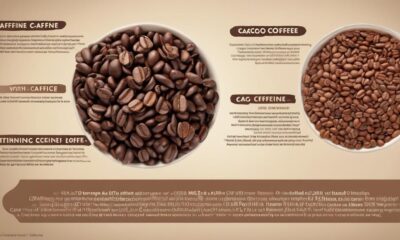
 Raw Food Ingredients4 weeks ago
Raw Food Ingredients4 weeks agoThe Truth Behind the Cacao Caffeine Myth
-
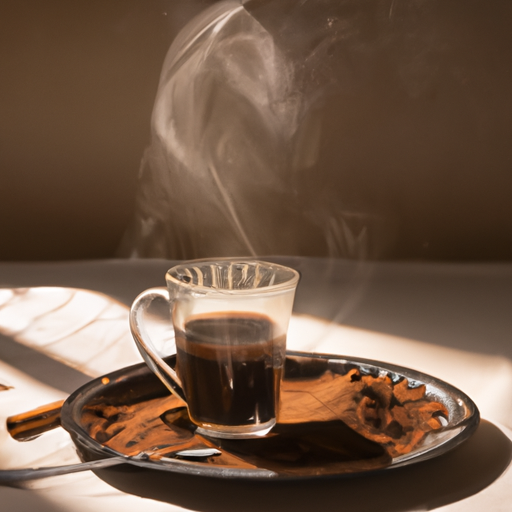
 Raw Food Ingredients2 months ago
Raw Food Ingredients2 months agoWhen Fasting Can I Drink Coffee With Raw Cacao Powder
-

 What is Raw Food?2 weeks ago
What is Raw Food?2 weeks agoHow To Store Raw And Cooked Food Separately
-

 Raw Food Ingredients2 months ago
Raw Food Ingredients2 months agoHow To Use Raw Cacao Beans




